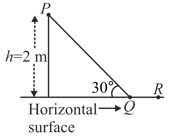A particle of mass is initially at rest at the origin. It is subjected to a force and starts moving along the -axis. Its kinetic energy changes with time as , where is a positive constant of appropriate dimensions. Which of the following statements is (are) true?

Important Questions on Work, Energy and Power
A ball of mass is thrown vertically upward by applying a force by hand. If the hand moves while applying the force and the ball goes up to height further, find the magnitude of the force. Consider .
An athlete in the Olympic Games covers a distance of in . His kinetic energy can be estimated to be in the range
When a rubber-band is stretched by a distance , it exerts a restoring force of magnitude where a and b are constants. The work done in stretching the un stretched rubber-band by is
A point particle of mass , moves along the uniformly rough track as shown in the figure. The coefficient of friction, between the particle and the rough track equals . The particle is released, from rest, from the point and it comes to rest at a point . The energies, lost by the ball, over the parts, and , of the track, are equal to each other, and no energy is lost when particle changes direction from to . The values of the coefficient of friction and the distance are, respectively, close to

